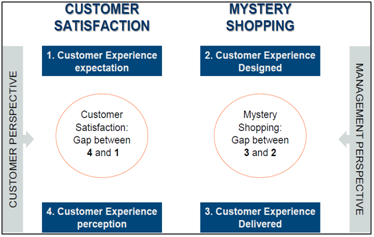So, I hear mystery shopping is an outdated modality?*
At the MSPA-EU conference in Malta in May this year, Herve Fauve (Head: Total Top Service, Total) and I presented a topic that went along the lines of:
‘It’s not about choosing between customer experience and mystery shopping measurement but using both effectively to support Total’s goal of delivering better service to its customers.’
Herve was able to succinctly present how Total uses each measurement effectively but also illustrated how, when applied incorrectly, can lead to misleading insights.
I presented fellow Board member, Cris Oliviera’s very clear graphic on how to correctly apply each methodology:
I further added that regardless of the methodology, ‘… the fundamentals of good research must [always] be in place…’
On arriving back in my home base on the African continent for our version of winter – 3-months of cold nights and warm, sunny days – I was confronted by three unrelated events that cast a massive spotlight on the themes we had presented in Malta.
“Mystery shopping is an outdated modality”
The first was a client visit by colleague of mine. This client, a large pharmacy retailer in southern Africa, told my colleague: ‘… mystery shopping is an outdated modality …’ and that they had elected instead to focus on customer satisfaction measurement.
Puzzled by this statement, we pressed the client for more details – which one was it:
Were their objectives different (in that they needed to focus on customer perceptions) and did they believe that mystery shopping could not answer these?
Or, indeed, in their view, was mystery shopping outdated?
The client elaborated, confirming that their objective was to understand the gap between customer experience designed versus what is delivered in their stores, BUT, their experience of mystery shopping had failed to provide this understanding for them. Moreover, stores hated the methodology and they had to focus more on damage control than on the outcomes of the intervention.
Following further investigation, including a consideration of the questionnaire utilised, we better understood the root cause of this client’s perception of mystery shopping.
The questionnaire was seriously flawed, set-up by somebody who clearly had no understanding of mystery shopping methodology.
The client divulged the name of the agency, which was unknown to us: essentially a fly-by-night who must have thought that doing mystery shopping was a no-brainer!
The outcome of this first tale is not a good one: the client is adamant that mystery shopping is an outdated modality. The damage has been done.
My challenge to clients is to closely assess who they choose as their mystery shopping provider. And here, the MSPA has a vital role to play: continuing to communicate the need for professional standards in mystery shopping. For users of mystery shopping, my request to you is to select providers who are MSPA members – they have pledged their adherence to MSPA standards.
“So, any research agency can do mystery shopping?”
Tale number two follows the same pattern: badly executed mystery shopping but this time not by a fly-by-night, but in fact by one of the well-known large research houses.
As would be expected, the questionnaire was well-designed, if a little too ‘researchy’!
But the execution was completely off kilter: the fieldworkers were not trained mystery shoppers and their observations were more anecdotal than objective commentaries on the customer experience delivered.
As such the client, a cable service provider across Africa, was unable to effectively discern any actionable findings.
Fortunately, this tale had a positive outcome and the client was willing to give mystery shopping another go.
My challenge to the full service research houses: just as we as mystery shopping providers do not accept advertising research projects, where we don’t have the expertise, by the same token, don’t do mystery shopping unless you have the skills to do so!
Here the MSPA is happy to help: there are ongoing training courses, learning opportunities for our members through support via website chat, forums, e-learning and certification coordinated by our excellent MSPA Training Team.
Finally, which mystery shopping agency do you choose?
You would think that this last tale applies to clients or users of mystery shopping but in this case or tale, applied to me – or should I say – our business.
As a mystery shopping provider across Africa, we generally utilise our own mystery shopper panel for executing our fieldwork. But in some cases we work with fieldwork partners – other mystery shopping providers – to augment our coverage.
In order to do so, standard practice is to pay the agency a deposit – typically around 50% upfront – before the commencement of fieldwork.
In executing one such project, we chose a new partner – a non-MSPA member – who had been imploring us to give them a try.
Milestone dates came and went, but the agency assured us there was activity. Eventually, after missing several deadlines, and with the overall project at risk, we appointed another agency.
To rub salt into our wounds, the original agency finally admitted they actually never had the capacity to take on the fieldwork, and, despite promising to return our deposit, to date have not done so.
My final challenge is to myself (and indeed other mystery shopping agencies)! Only work with partners who are members of the MSPA. I’m happy to say I’ve already started responding to my challenge.
Expanding in Africa is another ongoing focus of the MSPA and following the first successful conference in Morocco earlier this year, it will become a regular feature on the MSPA calendar. Through our efforts, we are seeing increasingly more members from Africa joining the MSPA. May this continue – more overall awareness will improve the level of mystery shopping providers and ensure we don’t become an ‘outdated modality’!
Ian Jeffrey
MSPA EU Board Member & Managing Director – Helion South Africa
* The article is re-published with the kind permission from MSPA Europe, which is the Mystery Shopping Professionals Association in Europe. You can read and comment on the original piece on their website. Original date of the publication: 12 September 2016.
Photography: Post it! 1 by Piotr Bizor, FreeImages.com


